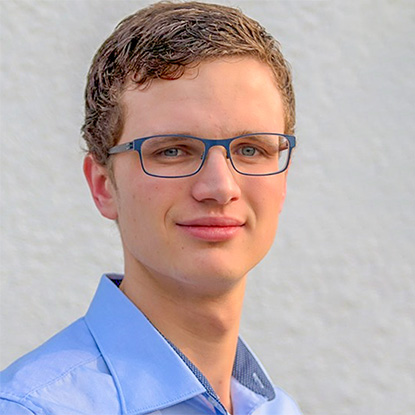Team
| Name | Contact | |
|---|---|---|

Picture: KIT
| Dr.-Ing. Heiko Kubach | heiko.kubach@kit.edu +49 721 608-43636 |

Picture: KIT
| Prof. Dr. sc. techn. Thomas Koch | thomas.a.koch@kit.edu +49 721 608-42430 |

| Jan Reimer M.Sc. | jan.reimer@kit.edu |
Motivation
The simultaneous reduction of fuel consumption and emissions is a challenge for engine developers. Downsized internal combustion engines and the use of fuels produced from renewable energy (E-Fuels) are a path leading to a solution. These downsized engines are characterized by a smaller combustion chamber while retaining their power output. The engines are charged to compensate for the smaller combustion chamber. Therefore the engines operate at higher loads which results in higher efficiency. Direct injection and high load lead to large quantities of fuel which have to be injected into the combustion chamber. Due to small combustion chambers and the injection of large quantities, the spray-wall-interaction is increased. This interaction can cause so called secondary droplets in the gas mixture and can lead to self-ignition.
Objectives
Different effects causing pre-ignition are discussed in the literature. The influence of combustion chamber deposits on pre-ignition has been shown and discussed several times in the literature. However, it has also been shown, that shedding oil at the cylinder liner and the top land has an influence on this phenomenon. But fundamental knowledge of the shedding mechanism of oil by interactions of fuel-droplets with the liner is missing. The theory of the absorption of fuel in oil and so caused decreasing viscosity, which leads to higher rates of pre-ignition, was investigated in targeted experiments on modern engines and could not be confirmed. Because of this contradiction and the lack of knowledge of the fundamental mechanism of pre-ignition a detailed investigation of the interaction of fuel-droplets and the oil film on the liner will be in focus of this subproject.
Previous Findings
Spray-wall interaction and deposit formation in SI-engines was investigated. Systematic analysis of the influence of operating conditions on the topographic surfaces of deposits and their impact on the wall-proximity flow was done. In addition, the use of e-fuels and their influences on the spray properties (1a) and the deposit formation (1b) were studied. It was shown that cylinder head deposits decrease with increasing DMC content in the fuel (1c).
In addition, the spray-wall interaction was optically investigated in detail. For this purpose, a spin coater was developed (2a) which is able to generate a reproducible oil film with adjustable thickness (2b). Furthermore, an experimental setup was developed with which the interaction can be observed with high spatial and temporal resolution. For this purpose, a multi-hole injector was modified into a single-hole injector (2c).
A pressure chamber was also constructed, which ensures the positioning of the spincoater and the injector relative to each other and has sufficient optical accessibility. A LIF tracer setup was developed to visually separate the fluids fuel and oil (3a). To do this, two tracers were selected that exhibited different florescence spectra at the same excitation (3b).
The interaction could be investigated with a high-speed polychromatic camera and both fluids could be visualized in different colors (4). From these observations, conclusions could be drawn about the composition and formation mechanisms of, for example, secondary droplets.
Approach
The examination of combustion processes and interaction of multi-phase flows requires different accessibility for optical measurement methods. For this subproject and the different condition for the investigations four test-benches will be used:
Injection-pressure-chamber: The chamber has a volume of 6.2 liter and a maximum inside pressure of 75 bar. The inert atmosphere and operating pressure is generated and regulated by a continuous flow of nitrogen. A heating cartridge adjusts the temperature up to 450°C. Four of five ports of the chamber can be used for the injection and optical access.
Thermodynamic single-cylinder engine: A thermodynamic single-cylinder engine is used to investigate the insulating effect of deposits under realistic conditions. The measurements will be performed using fast surface temperature sensors and endoscopic access for optical analysis.
Oil-layer-pressure-chamber: In this chamber, similar to an Injection-pressure-chamber (see above), it is possible to simulate pressure and temperature operating conditions like in turbo charged engines at full load. There are three ports at a 90° angle horizontal to each other for optical access. A special device generates oil films with a thickness of <20 µm to investigate the interaction between fuel droplets and oil films.
Ignition-chamber: The cylindrical chamber is 134mm long and has a diameter of 28 mm. The chamber has one port for optical measurements and can be heated up to 500°C. The maximum inside pressure is 350 bar. It is possible to analyze the combustion of oil droplets in a hot gas atmosphere thermodynamically and optically with pressure sensors and high-speed-cameras.
Current Work
Currently, the spray-wall interaction is being systematically investigated. For this, different optical setups are necessary to better describe the individual phenomena. In addition to the camera position, the lens is also adjusted and the spatial resolution is significantly increased by using a long-distance microscope. Thus, the phenomena can be described in more detail. Furthermore, the parameters impact angle, fuel pressure, oil film thickness, oil film temperature and ambient pressure are varied and their influence on the interaction processes is characterized.
Cooperations
One target of this subproject is to extend the knowledge of deposit formation by use of E-fuels. The gained measurement-data and information are shared with A01 for generic experiments and B01 for simulation models. Investigations of the interaction of fuel-droplets and the oil film and the so caused drop separation is done in close exchange on experimental level with C01 and with A04 regarding measurement-systems and interpretation of findings. Together with A05 we are going to determine the thickness of the oil layers. The detection of the splash-drops and interpretation of the measurements is supported by A02, which also provides the simulation model for the splash-limits. The measurement results are shared also with B08 for comparison with the results of numerical simulations.








